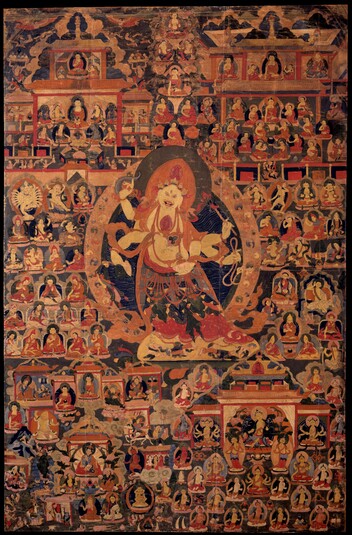
Item: Mahakala (Buddhist Protector) - Shadbhuja, Sita (White, Shangpa)
| Origin Location | Tibet |
|---|---|
| Date Range | 1700 - 1799 |
| Lineages | Nyingma, Sakya, Kagyu, Gelug and Buddhist |
| Size | 87.00x54.61cm (34.25x21.50in) |
| Material | Ground Mineral Pigment on Cotton |
| Collection | Rubin Museum of Art |
| Catalogue # | acc. #C2002.9.2 |
Classification: Deity
Appearance: Wrathful
Gender: Male
Shadbhuja Sita Mahakala, (Tibetan: gon po kar po chag drug pa. English: the White Lord with Six Hands): emanation of Avalokiteshvara and principal wealth deity of the Shangpa Kagyu Tradition of Tibetan Buddhism. (See the Sita Shadbhuja Main Page, Shadbhuja Mahakala Main Page and Outline Page).
White Mahakala, a wealth deity of the Kriya class of Tantra, satisfies the economic needs of Tantric Buddhists. This is an ecumenical example, both in the composition and central subject, of a deity that has become popular within all of the Sarma 'New' schools of Tibetan Buddhism. It should be noted however that the Shangpa Kagyu School, founded by Khedrup Khyungpo Naljor (11th century), is unrelated to the more famous school also using the name 'kagyu' founded by Marpa and his principal student Milarepa.
"Homage to Lord Chintamani, Holy Avalokiteshvara, the gathered compassion of all Buddhas of the ten directions and three times; to that emanation, the Six Handed Protector, devotedly with body, speech and mind I bow." (Common liturgical verse).
Lineage: Vajradhara, Jnana Dakini, Shri Shavaripa, Lord Maitripa, Mahasiddha Rahulagupta, Khedrup Khyungpo Naljor, Nyamme Rinchen Tsondru, Bonton Kyergangpa (famous terton of the Hayagriva cycle of practice), etc
Numbered & Coloured Schematic:
1 Yellow Section: Amitabha Buddha in the pureland of Sukhavati accompanied by the Eight Great Bodhisattvas. This section represents Mahayana Buddhism.
2 Blue Section: Vajradhara and Shakyamuni Buddha representing the general lineage of teachers.
3 Red Section: Shakyamuni Buddha along with the two principal disciples, Sixteen Arhats, Attendants and Four Guardian Kings. This section represents the original Buddhism referred to as 'Hinayana' in Himalayan and Tibetan Buddhism.
4 Brown Section: Teachers and deities of the Sakya Tradition. The following three sections represent the principal traditions of Buddhism that are practiced in the Himalayan regions, Tibet, parts of China and Mongolia.
5 Green Section: The Six Ornaments and Two Excellent Ones along with the Eighty-four Mahasiddhas with only a couple of representations of each. In addition there are the teachers and deities of the Marpa Kagyu and Gelug Traditions.
6 Purple Section: Padmasambhava together with the Eight Manifestations and narrative scenes of the Nyingma Tradition.
7 Violet Section: Green Tara along with the Twenty-one Taras of the Atisha Tradition and the Pancharaksha Five Goddesses. This section depicts two groups of popular Tantric meditational deities. Their placement here in the composition would be a choice of the artist or donor of the painting. This also accounts for the choices of figures in general and especially for the choices of deities represented in the different sections. It is also important to note that the central figure of White Shadbhuja Mahakala has no specific relationship with any of the seven surrounding sections.
Jeff Watt 8-2011
Buddhist Protectors: Enlightened
Buddhist Protector: Mahakala Main Page
Collection of Rubin Museum of Art (RMA): Main Page
Subject: Wealth Deities Main Page
Mahakala: Shadbhuja, White (6 Hands, Shangpa)



